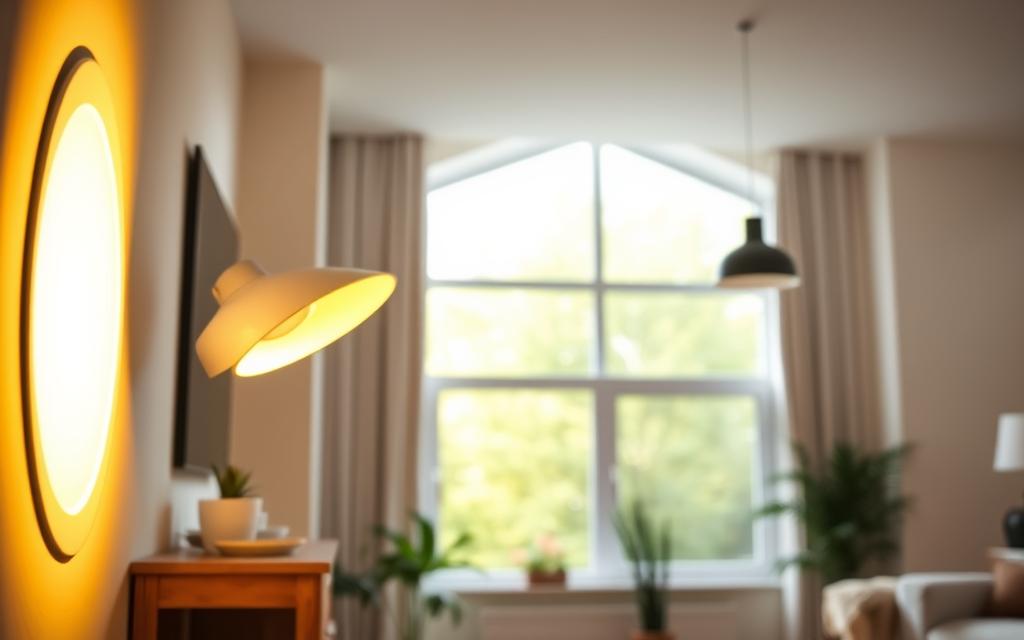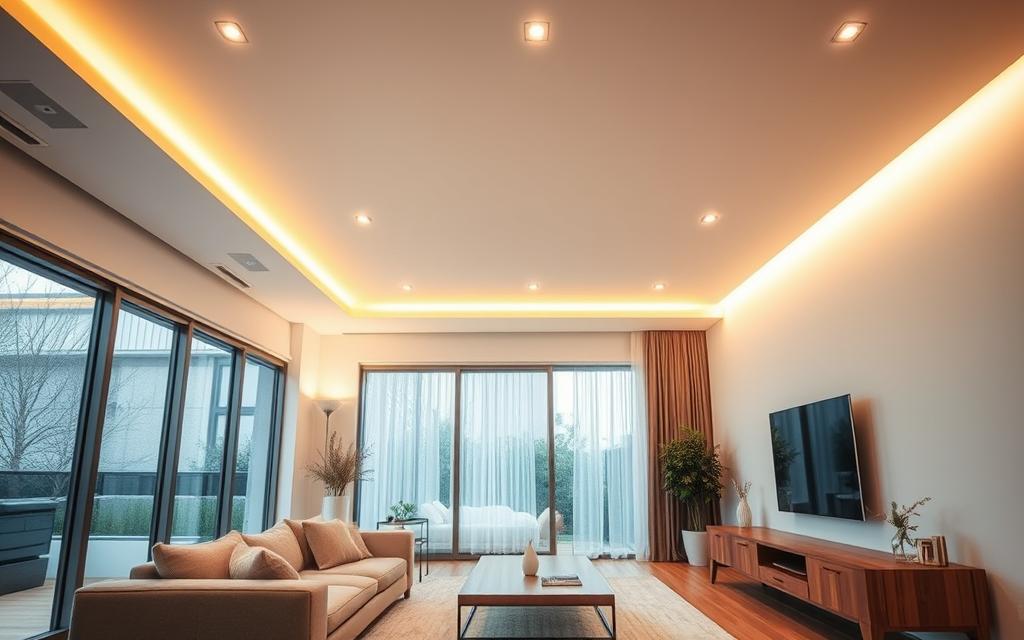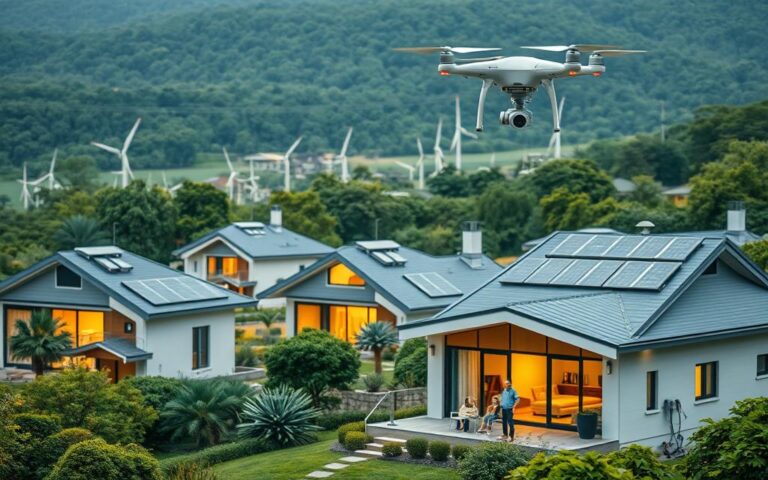Did you know that energy-efficient lighting makes up about 15% of a typical home’s electricity use? With energy costs going up and more focus on green lighting, picking the right lighting for your home is key. LED and ENERGY STAR-certified lights can cut down your energy use and still light up your space well.
This guide will help you find the best energy-saving lighting for your home. It’s all about saving money and being kind to the planet when you’re improving your home.
Understanding Energy-Efficient Lighting
Energy-efficient lighting uses new technologies to save a lot of energy while still giving good light. LED bulbs and CFLs are great alternatives to old incandescent bulbs. Knowing about these options helps homeowners choose the best for their homes and the planet.
What is Energy-Efficient Lighting?
Energy-efficient lighting is made to shine bright but use less power. LED bulbs and CFLs use less electricity than old bulbs. They also last much longer, saving money and resources.
Benefits of Energy-Efficient Lighting
Choosing energy-efficient lighting has many benefits. Here are some:
- It can save over $225 a year on energy bills with LED lighting.
- LED bulbs last up to 25 times longer than old bulbs.
- It helps reduce greenhouse gas emissions, making the air cleaner.
- It makes homes more energy-efficient, helping both people and the planet.
Types of Energy-Efficient Lighting
Today, we have many energy-saving lighting options. Each has its own benefits. Knowing about these can help homeowners choose better for the planet.
LED Lighting
LED bulbs are a top choice for saving energy. They use up to 90% less power than old bulbs. You can find them in many styles, perfect for indoor and outdoor use.
LEDs last a long time. This means you won’t need to replace them often. It’s good for the environment and saves you money.
CFL Lighting
CFLs save a lot of energy, about five times more than old bulbs. They fit in most light fixtures, making them easy to use. Even though they cost more upfront, they save you money in the long run.
Halogen Lighting
Halogen lights are better than old bulbs. They give brighter, steadier light and use less energy. They’re great for both looks and function, lasting longer than regular bulbs.
How to Evaluate Your Lighting Needs
Finding the right lighting for your home is important. It makes your space better and helps save energy. You need to think about how you use each room and how bright you want it.
Assessing Room Functionality
Every room in your home has its own purpose. Kitchens and study areas need bright, focused light for tasks. Bedrooms and living rooms are better with softer, ambient light. Knowing this helps you pick the right lighting for each room.
Determining Brightness Levels
It’s key to understand lumens for the right light. More lumens mean brighter light, great for work areas. Less lumens create a cozy feel. Using dimmers lets you adjust the light, saving energy and making your space more comfortable.
Energy-Efficient Bulb Lifespan and Costs
Energy-efficient lighting, like LED and CFL bulbs, has changed how we light our homes. It’s important to know how long they last and what they cost. This helps homeowners decide if it’s worth the switch.
Lifespan Comparisons
Energy-efficient bulbs last much longer than old-fashioned incandescent bulbs. For example, LED bulbs can go up to 25,000 hours. That’s a lot longer than the 1,000 hours incandescents last. This means you won’t need to replace them as often, which is good for the planet.
Initial vs. Long-Term Costs
When looking at energy-efficient lighting, the initial vs. long-term costs are key. LED bulbs might cost more upfront than incandescent bulbs. But, they save money on energy bills and last longer, making them a smart choice in the long run.
Color Temperature and Brightness
When picking energy-saving lights, knowing about color temperature and brightness is key. These aspects help create the right mood and function in any space. They make your home look better and work better too.
Understanding Color Temperature
Color temperature is measured in Kelvin (K). It changes the mood of a room. Warmer tones, with lower Kelvin values, make spaces feel cozy and welcoming.
Cooler, brighter white light, with higher Kelvin values, boosts focus and alertness. Picking the right color temperature is crucial for each room’s purpose.
Choosing the Right Brightness
Brightness, in lumens, is vital for each room’s function. Kitchens and workspaces need bright lights. Bedrooms and living areas prefer softer light.
Smart home tech makes adjusting brightness easy. This lets you change light levels for different activities or times. Smart home tech and eco-friendly lights work together for the best performance and energy use.
Installing Energy-Efficient Lighting
Installing energy-efficient lighting can make your home look better and help the planet. Many people choose to do this themselves because it’s easy. You only need basic tools for simple projects.
DIY Installation Tips
When you start a DIY energy-efficient lighting project, keep these tips in mind:
- Turn off power to stay safe while you work.
- Read the instructions from the manufacturer carefully.
- Use the right tools like screwdrivers and pliers.
- Make sure your wiring fits the light fixtures.
- Choose energy-efficient bulbs for better light and savings.
When to Call a Professional
Some jobs are too hard for DIY. If you need to rewire or use special fixtures, get a pro. Electricians can:
- Make sure everything follows local electrical rules.
- Do the job right and safely.
- Fix any problems that come up.

Maintaining Your Energy-Efficient Lights
Keeping your energy-efficient lights in good shape is key. It helps them work their best and saves energy at home. Regular care also makes your bulbs last longer, which is great for the planet.
Regular Cleaning and Care
Dust and dirt can cut down light and make you use more energy. Clean your bulbs and fixtures often to keep them efficient. Use a soft cloth or a gentle cleaner to avoid damage.
This simple step keeps your lights bright and your energy use down.
Knowing When to Replace Bulbs
It’s important to know when a bulb needs to be replaced. Look out for flickering, dimming, or buzzing. Replacing bulbs quickly keeps your lighting consistent and saves energy.
Doing this also makes sure you get the most out of your eco-friendly lighting.
Incentives for Energy-Efficient Upgrades
Switching to energy-efficient lighting can cut down on your energy bills. There are many financial incentives to help you make this change. Homeowners can get government rebates and local utility company offers to make these upgrades more affordable.
Government Rebates and Programs
Homeowners can get help from government programs to use energy-efficient lighting. ENERGY STAR offers rebates and tax credits for certain products. These incentives help lower the cost upfront and save money in the long run by using less energy.
Local Utility Company Incentives
Local utility companies also offer incentives for energy-efficient lighting. They might give discounts or rebates for buying ENERGY STAR-rated products. These programs help families save money on electricity while being kind to the environment.
| Incentive Type | Description | Potential Savings |
|---|---|---|
| Government Rebates | Rebates and tax credits for qualifying energy-efficient products. | Up to $500 |
| Utility Company Rebates | Financial incentives for purchasing ENERGY STAR-rated lighting. | Varies by region but can reach $200 |
| Tax Credits | Credits available on your federal tax return for energy-efficient upgrades. | Up to 30% of installation costs |
Creating an Eco-Friendly Lighting Plan
To make a good eco-friendly lighting plan, mix sustainable lighting with energy efficiency and home style. It’s key to blend natural and artificial light well. By placing windows and skylights right, you use more daylight. This cuts down on electric use while keeping your home bright and welcoming.
Combining Natural and Artificial Light
Using natural light makes your home brighter and cuts down on carbon emissions. Adding shades and light colors helps reflect light, making rooms brighter without needing more electric lights. Using LED or CFL bulbs for night time makes your home energy-smart.
Tips for Smart Home Integration
Smart home tech makes your lighting plan even better. Systems like smart bulbs and controls let you set timers and moods for your day. This tech boosts convenience and saves energy, fitting your lifestyle perfectly.



